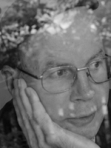As interesting as the theory behind concrete poetry is it is not my favourite form of poetry. The experimentation in the aesthetics of language is sometimes beautiful and sometimes interesting, but I often struggle to understand the meaning behind the word art. Perhaps there is no meaning other than a celebration of the text, or it may be that I am unable to see beyond the visual.
Two poems in the edition that I did find meaning in as well as aesthetic interest are Jill Jones' 'While It Seems' and James Stuart's 'Adrift and Out'.
In 'While It Seems' the persona moves through long grasses: "among the floating mass", "in the spider season". Through the positioning of words, the pace of the poem and her lexicon Jones appeals to all of the senses and reconstructs this place, leaving us there with the wind:
there is not always need for wordsPhotographs of emergency radios in remote Australia are the back drop to the poem 'Adrift and Out', which contrasts the "carbon copy windows" of the city with the openness of the outback. Stuart tells of the role that the radio plays in rural Australia, a cry for help in times of emergency and a link to the noise of humanity and a blending of remote and urban living: "words & music / stars smudging / to black water".
to rest the wind takes the rest
You can read Bronwyn Lea's full forward here.
You can purchase the journal here.
You can read more of Jill Jones' poetry at http://www.jilljones.com.au/index.html
You can read another review of this edition at Rochford Street Review here.


.jpg)